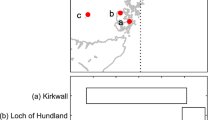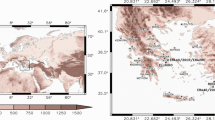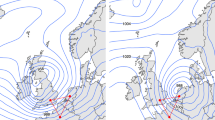Abstract
This paper is concerned with the use of Royal Navy ships’ logbooks for the period 1685 to 1750, thereby embracing the oldest members of this documentary series that extends to the present day. The geographic range of the undertaking is confined to the English Channel and its western approaches where the abundance of logbooks for this period allows for the abstraction of a daily series of wind force and direction data. These are verified and processed for inclusion in a database from which indices are derived for air circulation patterns based on the frequency of winds from north, east, south and west quarters, and of gale frequency, based on the contemporary terminology of wind force. The methods by which the data are abstracted and processed are described, as is the nature of the raw data and source material. The results provide a uniquely detailed insight into the changing patterns of air circulation over this critical period that marked the transition from the depths of the Little Ice Age in the late seventeenth century. Attention is also drawn to the changing nature of gale frequency, which revealed a notable decrease over the study period. Associations between changing circulation patterns and temperature regimes are also explored.
Similar content being viewed by others
References
Brázdil R, Pfister C, Wanner H, von Storch H, Luterbacher J (2005) Historical climatology in Europe—state of the art. Clim Change 70:363–430
Cullen HM, D’Arrigo RD, Cook ER (2001) Multiproxy reconstructions of the North Atlantic Oscillation. Paleoceanography 16:27–39
Defoe D (1704) The storm: or, a collection of the most remarkable casualties and disasters which happen’d in the late dreadful tempest by both sea and land. London
Eddy J (1976) The Maunder Minimum. Science 192:1189–1202
Gallego D, García-Herrera R, Ribera P, Jones PD (2005) Seasonal mean pressure reconstruction for the North Atlantic (1750–1850) based on early marine data. Climates of the Past 1:19–33
García-Herrera R, Können GP, Wheeler D, Prieto MR, Jones PD, Koek FB (2004) CLIWOC multilingual meteorological dictionary. Royal Dutch Meteorological Institute (KNMI) publication 2005, De Bilt, The Netherlands
García-Herrera R, Können GP, Wheeler D, Prieto MR, Jones PD, Koek FB (2005a) CLIWOC: a climatological database for the world’s oceans 1750- 1854. Clim Change 73:1–12
García-Herrera R, Wilkinson C, Koek FB, Prieto MR, Calvo N, Hernández E (2005b) Description and general background to ships’ logbooks as a source of climatic data. Clim Change 73:13–36
Harries H (1928) Nautical time. Mariner’s Mirror 364–70
Hewson JB (1983) A history of the practice of navigation. Brown, Son and Ferguson, Glasgow
Jackson A, Jonkers ART, Walker MR (2000) Four centuries of geomagnetic secular variation from historical records. Phil Trans R Soc Lond A 358:957–990
Jones PD, Briffa K (2006) Unusual climate in northwest Europe during the period 1730 to 1745 based on instrumental and documentary data. Clim Change 79:361–379
Jones PD, Hulme M (1997) The changing temperature of ‘Central England’. In: Hulme E, Barrow E (eds) Climates of the British Isles: past, present and future. Routledge, London, pp 173–196
Jones PD, Salmon M (2005) Preliminary reconstructions of the North Atlantic Oscillation and the Southern Oscillation index from measures of wind strength and direction taken during the CLIWOC period. Clim Change 73:131–154
Jones PD, Wheeler D, Jonsson T (1997) Extension to the North Atlantic Oscillation using early instrumental pressure observations from Gibraltar and south-west Iceland. Int J Climatol 17:1433–1450
Jönsson P, Holmquist B (1995) Wind direction in southern Sweden 1740–1992: variation and correlation with temperature and zonality. Theor Appl Climatol 51:183–198
Kington J (1994) Synoptic weather mapping, 1675 to 1715. In: Frenzel B (ed) Climatic trends and anomalies in Europe 1675–1715. Gustav-Fischer-Verlag, Stuttgart, pp 389–399
Kington J (1995) The severe winter of 1694/95. Weather 50:160–163
Kington J (1997) The severe winter of 1696/97. Weather 52:386–391
Kington J (1998) The great storm of 1–2 October 1697. Weather 53:424–428
Kington J (1999) The severe winter of 1697/98. Weather 54:43–49
Koek FB, Können GP (2005) Determination of wind force and present weather terms: the Dutch case. Clim Change 73:79–95
Können GP, Brandsma T (2005) Instrumental pressure observations from the end of the 17th century: Leiden (The Netherlands). Int J Clmatol 25:1139–1145
Können GP, Koek FB (2005) Description of the CLIWOC database. Clim Change 73:117–130
Küttel M, Xoplaki E, Gallego D, Luterbacher J, Garcia-Herrera R, Allen R, Barriendos M, Jones PD, Wheeler D, Wanner H (2009) The importance of ship log data: reconstructing North Atlantic, European and Mediterranean sea level prerssure fields back to 1750. Clim Dyn. doi:10.1007/s00382-009-0577-9
Lamb HH (1978) A meteorological study of July to October 1588: the Spanish Armada storms. CRU report no.6, University of East Anglia, Norwich
Lamb HH (1982) Climate, history and the modern world. Methuen, London
Lamb HH (1988) Cold, disturbed climate periods. In: Lamb HH (ed) Weather, climate and human affairs. Routledge, London
Lamb HH (1991) Historic storms of the North Sea, British Isles and Northwest Europe. Cambridge University Press, Cambridge
Luterbacher J, Rickli R, Xoplaki E, Tinguely C, Beck C, Pfister C, Wanner H (2001) The late Maunder Minimum (1675–1715)—a key period for studying decadal scale climatic change in Europe. Clim Change 49:441–462
Luterbacher J, Schmutz C, Gyalistras D, Xoplaxi E, Wanner H (2002) Extending north Atlantic Oscillation reconstructions back to 1500. Atmos Sci Lett 2:114–124
Luterbacher J, Dietrich D, Xoplaki E, Grosjean M, Wanner H (2004) European seasonal and annual temperature variability, trends and extremes since 1500. Science 303:1499–1503
Manley G (1958) The great winter of 1740. Weather 13:11–17
Manley G (1974) Central England temperatures, monthly means: 1659 to 1973. Q J R Meteorol Soc 100:389–405
Meteorological Office (1975) Weather in home waters, vol. II: the waters around the British Isles and the Baltic, part 1. HMSO, London
Meteorological Office (1983) State of sea booklet. Met. O. 688b, HMSO, London
Oke T (1978) Boundary layer climates. Methuen, London
Parker DE, Legg PT, Folland CK (1992) A new daily Central England temperature series. Int J Climatol 12:317–342
Pfister C (1999) Wetternachhersage. 500 Jahre Klimavariationen und Naturkatastrophen 1496–1995. Paul Haupt Verlag, Stuttgart
Siegenthaler D (1994) Climatic trends and anomalies in England 1675 to 1715. In Frenzel B (ed.) Climatic trends and anomalies in Europe 1675-1715. Gustav-Fischer-Verlag, Stuttgart, pp 133–149
Slonosky VC, Yiou P (2002) Does the NAO index represent zonal flow? The influence of the NAO on North Atlantic surface temperatures. Clim Dyn 19:17–30
Slonosky VC, Jones PD, Davies TD (2001) Instrumental pressure observations and atmospheric circulation from 17th and 18th centuries: London and Paris. Int J Climatol 21:285–298
Wanner H, Brázdil R, Frich P, Fryhendahl K, Jonsson T, Kington J, Pfister C, Rosenørn, Wishman E (1994) Synoptic interpretation of monthly weather maps for the late Maunder Minimum (1675–1704). In: Frenzel B (ed.) Climatic trends and anomalies in Europe 1675–1715. Gustav-Fischer-Verlag, Stuttgart, pp 401–424
Wanner H, Pfister C, Brázdil R, Frich P, Frydendahl K, Jónsson T, Kington J, Lamb HH, Rosenørn S, Wishman E (1995) Wintertime European circulation patterns during the Late Maunder Minimum cooling period (1675–1704). Theor Appl Climatol 51:167–175
Wheeler D (2003) The Great Storm of November 1703: a new look at the seamens’ records. Weather 58:419–427
Wheeler D (2005) An examination of the accuracy and consistency of ships’ logbook weather observations and records. Clim Change 73:97–116
Wheeler D (2006) Archives and climatic change: how old documents offer a key to understanding the world’s weather. Archives 31:119–132
Wheeler D (2008) The European environment. In: Wilson P (ed) A companion to eighteenth century Europe. Blackwell, London
Wheeler D, Garcia-Herrera R (2008) Ship’s logbooks in climatological research: reflections and prospects. Ann NY Acad Sci 1146:1–15
Wheeler D, Suarez-Domiguez J (2006) Climatic reconstructions for the northeast Atlantic region AD1685–1700: a new source of evidence from naval logbooks. Holocene 16:39–49
Wheeler D, Wilkinson C (2004) From calm to storm: the origins of the Beaufort Wind Scale. Mar Mirror 90:187–201
Wheeler D, Wilkinson C (2005) The determination of logbook wind force and weather terms: the English case. Clim Change 73:160–185
Woodruff S, Diaz H, Worley S, Reynolds R, Lubker S (2005) Early ship observational data and ICOADS. Clim Change 73:169–194
Xoplaki E, Luterbacher J, Paeth H, Dietrich D, Steiner N, Grosjean M, Wanner H (2005) European spring and autumn temperature variability and change of extremes over the last half millennium. Geophys Res Lett 32:L15713
Author information
Authors and Affiliations
Corresponding author
Additional information
An erratum to this article can be found at http://dx.doi.org/10.1007/s10584-009-9755-3
Rights and permissions
About this article
Cite this article
Wheeler, D., Garcia-Herrera, R., Wilkinson, C.W. et al. Atmospheric circulation and storminess derived from Royal Navy logbooks: 1685 to 1750. Climatic Change 101, 257–280 (2010). https://doi.org/10.1007/s10584-009-9732-x
Received:
Accepted:
Published:
Issue Date:
DOI: https://doi.org/10.1007/s10584-009-9732-x




